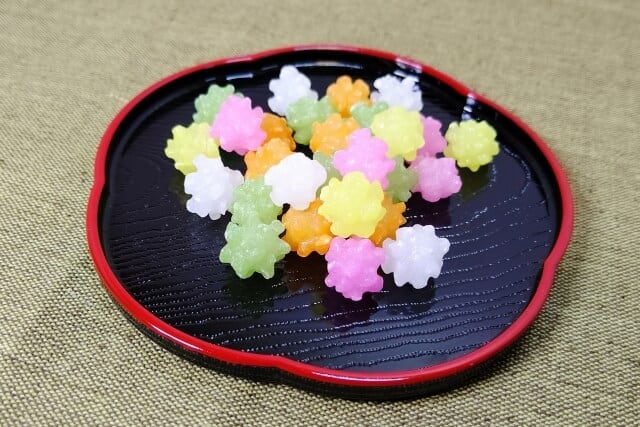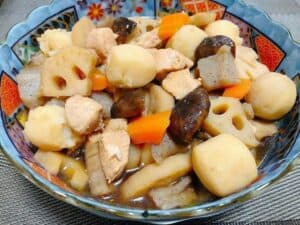If you visit some random candy stores in Japan, you can easily find the star-like candies called “Konpeito”. This candy is so popular in Japan that it is also used in many special occasions. It is said that there is no exact recipe for making this candy and it takes years to make a new flavored one. In this article, we are going to introduce about its history, various flavors, some tips on choosing and recommended Konpeito.
What is Konpeito?
Konpeito is a small ball-shaped Japanese confectionery made from sugar and seasoned water. Some families display them together with Hinamatsuri dolls at the Doll’s Festival, and at royal weddings, locals gave them out in a bowl called a bonbonniere as a gift. It was transported from Portugal to Kyushu and western Japan as Nanban sweets, together with castella and ariheito.
“Konpeitou” looks like a star and is very cute. Although it resembles candy, it is not hard like a candy, and you can enjoy the crunchy texture that crumbles when you put it in your mouth. Colourful grains such as white, pink, yellow, and yellowish green and flavoured with spices.
Etymology

The word konpeitō comes from the Portuguese word “confeito (comfit)”, which is a type of sugar candy. The characters “金平糖 “ (lit. “golden flat sugar”) are ateji selected mostly for their phonetic value and written as “金米糖 “or “金餅糖”.
Konpeito History

Konpeitou with cute corners is a dream candy for children and a nostalgic treat for the elderly. Because everyone is familiar with konpeitou, many people believe it originated in Japan, but this is not the case. About 460 years ago, at the end of the Muromachi period, the Portuguese arrived at Tanegashima in the south of Kyushu. Twenty years later, a Portuguese missionary named Frois visited Japan and presented konpeitou to warlord Nobunaga Oda. Locals considered this a rare item that only court nobles and high-ranking samurai could eat, and the manufacturing method was a secret.
At that time, they called the konpeitou as confeitos, and have been a rare delicacy. “China Marble” is also a Nanban confectionery introduced from Portugal. The konpeitou, which came from Nanban, existed in Japan for about 100 years. However, at the beginning of the Edo period, konpeitou was made by hand. A Nagasaki townsman who was a confectionery craftsman became interested in konpeitou, continued research for two years, and finally completed konpeitou. It began to be produced in Japan, spreading to Nagasaki, Kyoto, and Edo, and since then it has become popular with everyone.
Konpeito Recipe

There is no recipe for making konpeito, but the concentration of honey, the angle and temperature of the kettle, and locals used the sound of the konpeito rolling in the kettle to determine the state of the sugar, and this is a technique passed down from generation to generation, using all five senses. The troweling takes 10 years, honey takes 10 years, and konpeito takes 20 years. Additionally, making flavored konpeito is much more difficult than making sugar konpeito, and adding ingredients to sugar will not harden due to the addition of acid, oil, and salt.
Konpeito Ingredients
| Ingredients of Konpeito for 2 persons | Measurements |
|---|---|
| Granulated Sugar | 300g |
| Molasses | 800g |
How to make Konpeito
Put a handful of granulated sugar into a frying pan heated over low heat , add a little warm molasses, and stir with chopsticks so that they do not stick together.
If they stick together, break them apart. When the surface becomes dry and whitish, pour the molasses over and mix again.
If you repeat about 100 times, it will be about the size of a commercially available konpeitou.
At the beginning, the granulated sugar stuck to it became a large konpeitou.
Konpeito uses

This konpeito is a sweet that the imperial family loved as a gift for auspicious occasions such as weddings. They also distribute this to the attendees at imperial coronation ceremonies and weddings.The container used to distribute konpeitou as a gift called a bonbonniere and in Europe, they put the sugar confectionery in the bonbonnière and sent during celebrations. At the end of the meal, Japanese serve bite-sized sweets called petit fours, and that the custom of gift-giving, which was originally in Japan, combined with giving out konpeitou in bonbonnières.
Flavours of Konpeito

The appeal of konpeito is that you can enjoy a variety of flavours. Fruit flavours such as orange, apple, muscat, and pineapple are standard. If you prefer flavours for adults, we recommend bittersweet flavours such as matcha, sencha, hojicha, and coffee. In addition, there are spicy items such as cinnamon and ginger, and konpeito with unusual flavours using salt and sake lees. Please choose according to your taste.
Tips on Choosing Konpeito

By Capacity
When choosing konpeito, pay attention to the capacity. If you want to enjoy it a lot, we recommend the large-capacity type. Many of the products have a long shelf life, so it’s easy to keep in stock. A small amount of around 30 to 50g is perfect for small gifts and souvenirs.
By Colors
Konpeito has a star-like shape with horn-like projections on the surface and is attractive in color. If you choose to emphasize color, a colorful konpeitou that mixes several colors is perfect. Some products have different flavors for each color.
By Packaging
When choosing konpeito, check the package. It varies depending on the product, such as bags, cans, bottles, etc. Some of them have cute designs in bear-shaped bottles. If you want to casually enjoy konpeitou, we recommend reasonably priced bags. Also, small bottles, cans, paper tubes, and other stylishly packaged items are perfect for presents.
How is the bur of konpeito made?

Many have noted how konpeito burs (protruding parts) are produced. Simply put, as the sardine powder, which is the core, rolls from the top to the bottom of the pot, the honey that comes into contact with the iron plate dries and hardens. Because it protrudes slightly, honey sticks to it more easily than in other places, and the protruding part gradually grows larger and becomes a burr.
Recommended Konpeito
You can choose from different flavors but you can order online through Amazon or Rakuten. Here is the list of the recommended Konpeito from different manufacturers.
Konpeito Kingdom “Blueberry Konpeito”

Konpeito made with concentrated blueberry juice. It has an attractive fruity taste and a point that it is easy to store because it is in a bag with a zipper. It is convenient to carry as a snack when going out.
Ujien Seikaan “Apple Konpeito”

Konpeito spreads the sourness and sweetness of apples in your mouth. The beauty of the appearance and the delicate taste is attractive. Popular for gifts and souvenirs. The honey is blended in a unique ratio and stirred little by little.
Aoki Koetsudo “Konpeito gift box 8-color rainbow set”

Konpeito candy in a cute small bottle. An assortment set of 8 colours including rape blossoms, wisteria, forget-me-nots, and maples. Yellow is banana, pink is peach, blue is cider, and each colour has a different taste. You can also enjoy natural konpeitou coloured with natural materials such as gardenia, red beet, and safflower.
Takeaway

Making a konpeito requires great skill. Even though they utilised sugar as an ingredient, the process of making the konpeitou’s core is already challenging. Even more challenging, and taking two weeks to complete, is the technique of growing konpeitou crystals by expert craftsmen. When you hold the konpeitou in your hands, you could experience a sense of gratitude towards the artisans considering the difficult effort required.
If you’d like this article about Konpeito, you can also check Hina-arare which is similar to Konpeito.
















Comments